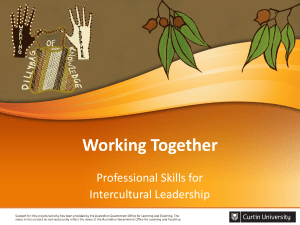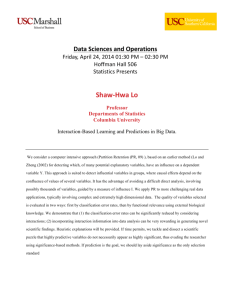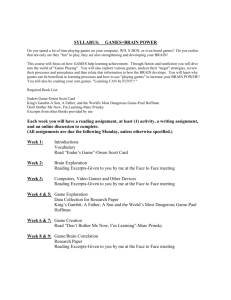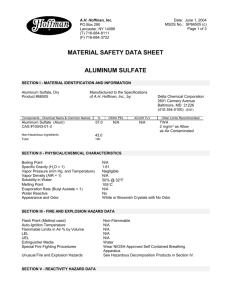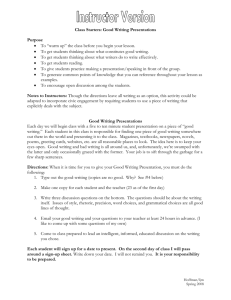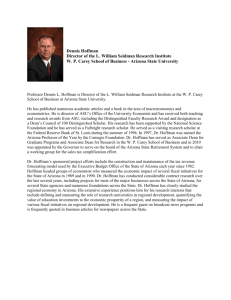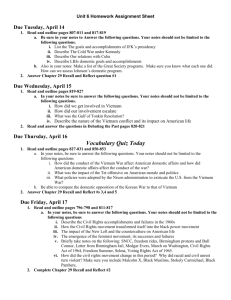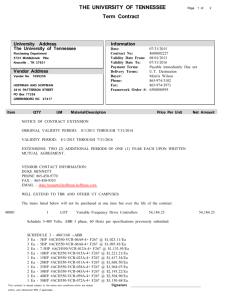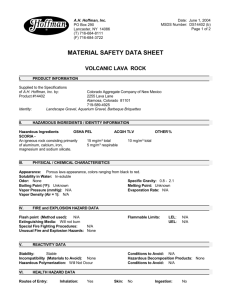Flower Power
advertisement
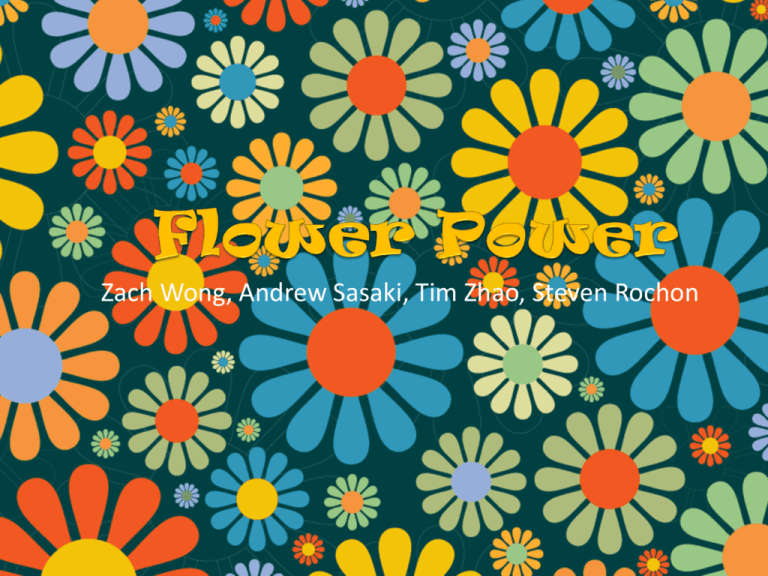
Zach Wong, Andrew Sasaki, Tim Zhao, Steven Rochon What is Flower Power? Flower Power was a Slogan used during the late 1960’s and early 70’s Had its roots in the opposition movement to the Vietnam War Coined by American beat poet Allen Ginsberg in 1965 as a means to make war protests into Peaceful spectacles Hippies dressed in vibrant clothing embroidered with flowers, wore flowers in their hair, and distributing flowers in public. Later became known as “Flower Children” Origins Originated in Berkeley California Started as a symbolic action of protest against the war in Vietnam November 1965- Allen Ginsberg’ s essay entitled How to Make a March advocated that protesters should be provided with “masses of flowers” to hand out to policemen, politicians, etc. Protestors began to use props such as flowers, toys, and flags that turned these rallies into a form of street theater called Guerilla theater. The protest received positive attention and the use of “Flower Power” became integral to the movement The Movements By Late ‘66, The use of theater protest had spread across the states The Bread and Puppet theater in NYC staged Numerous Protest which involved handing out flowers and balloons with their anti-war literature May 1967- Abbie Hoffman organized the Flower Brigade as an official contingent of a New York Parade honoring soldiers in Vietnam The Following Sunday, The Workshop in Non-Violence declared Armed Forces day as “Flower Power day”, and held a Rally in Central Park. Turn out was low, and the rally proved to be ineffective Gruesome images of two anti-war activists who lit them selves on fire in November 1965 provided iconic images of how strongly some people felt that the war was immoral 32 year old Quaker Norman set himself on fire in front of the Pentagon 22 year old Catholic worker movement member Robert Allan LaPorte did the same in front of the UN Headquarters in NYC October 1967- Abbie Hoffman and Jerry Rubin organize the March on the Pentagon. When Marchers faced off against more than 2500 Army National Guard troops forming a human barricade in front of the Pentagon Demonstrators held flowers and some placed flowers in soldiers rifle barrels The March on The Pentagon Abbie Hoffman Born November 30, 1936 Abbot Howard “Abbie” Hoffman was an American political and social activist and anarchist. He Co founded the Youth International Party (Yippies) Hoffman was arrested and tried for conspiracy and inciting to riot as a result of his role in protests that that led to violent confrontations with police during the 1968 Democratic National Convention. Before becoming a prominent member of the Yippie movement, Hoffman was involved with the Student Nonviolent Coordinating Committee, and organized Liberty House, which sold items to support the Civil Rights Movement in the States Jerry Rubin Born on July 14th 1938 Jerry Rubin was an American Social Activist, anti-war leader, and counterculture Icon during the 60’s and 70’s He began demonstrating on behalf of left wing causes after he dropped out of Berkeley He attempted to run as mayor for Berkeley, on a platform of opposing the Vietnam War, and supporting black rights and the legalization of marijuana Rubin organized the Vietnam Day Committee, that led to some of the first large numbered protests against the war in Vietnam One of the Founding Members of the Youth International Party “The more visual and surreal the stunts we could cook up, the easier it would be to got on the news, and the more weird and whimsical and provocative the theater, the better it would play” The Chicago Seven/Eight The Chicago Seven were seven defendants including Abbie Hoffman, and Jack Rubin. They were charged with conspiracy, inciting to riot and other charges related to counter cultural protests that took place in Chicago, Illinois in protest of the 1968 Democratic National Convention Rallies were held at a number of different parks in Chicago Over the course of five days and nights, the police made arrests, in addition to using tear gas, Mace, and batons on the marchers Jury indicted eight demonstrators and eight police officers. Four Charges: A conspiracy by protesters to cross state lines to incite a riot Violations by police of the civil rights of demonstrators by use of excessive force TV network violations of the Federal Communications Act TV network violations of federal wiretap laws. Allen Ginsburg Irwin Allen Ginsberg was an American Poet and one of the leading figures of the beat generation, and counterculture of the 1960’s He vigorously opposed militarism, economic materialism and sexual repression. Promoted free speech through his willingness to talk about taboo subjects made him a controversial figure in the conservative dominated beliefs His poem “Howl” contained language that was considered “Pornographic”, and could be prosecuted under law Had connections to Communism Believed in Rights LGBT Woodstock The Woodstock Music & Art fair was a music festival held at Max Yasgur’s 600-acre dairy farm at White Lake in Bethel, New York Lasted from August 15th to 19th 1969 32 acts performed outdoors in front of an audience of 500,000 People Performers included Joan Baez, Grateful Dead, Crosby Stills & Nash, Sly and the Family Stone, Jimi Hendrix , etc. During The Who’s Performance, Abbie Hoffman interrupted their performance to speak against the Jialing of John Sinclair “I think this is a pile of sh*t while John Sinclair rots in prison” Pete Townshend was tuning his guitar and shouted “F*ck off! F*ck off my stage!”, and hit him with his guitar. He later denied the accusations Townshend later said that while he actually agreed with Hoffman on Sinclair's imprisonment, he would have knocked him offstage regardless of the content of his message, given that Hoffman had violated the "sanctity of the stage,“ In Woodstock Nations, Hoffman recalls that he was on a bad LSD Trip at the time, but he does recall getting hit in the head by a guitar Counterculture Saw Development of Left wing political ideologies Developed concerns with other issues such as women's rights, human sexuality, traditional conservative modes of authority, experimentation with psychoactive drugs Brought in the rise of the hippie, and other alternative lifestyles This embracing of creativity is particularly notable in the works of British invasion bands such, and filmmakers, who became far less restricted to censorship This era of youth rebellion essentially commenced with the assassination of JFK, and became absorbed into popular culture with the termination of US military involvement in Vietnam, and the end of the draft in 1973 Sociological issues/Left winged ideals United States seeking to resolve constitutional civil rights illegalities, especially regarding general Racial Segregation, and discrimination of blacks in the South. On college and university campuses, student activists fought for the right to exercise their basic constitutional rights, especially freedom of speech and assembly Many counterculture activists became aware of the plight of the poor, and community organizers fought for the funding of anti-poverty programs Environmental concern grew from a greater understanding of the ongoing damage caused by the resulting pollution of industrialization. The Need to address rights for Women, Homosexuals, and Handicapped. The sexual revolution was a social movement that challenged traditional codes of behavior related to sexuality and interpersonal relationships throughout the 60’s to the 80’s Hippie Culture Originated in San Francisco, in the Haight Asbury District On January 14, 1967, after the Human Be-In, the Media’s attention on culture was activated Hippies adopted new styles of dress, experimented with psychedelic drugs, lived communally, and developed a vibrant music scene Men had very long hair, African American men had afros, Levi's denim, tiedyed t shirts, Converse sneakers etc. Marijuana, LSD and other Recreational drugs expanded into a subculture that extolled mystical and religious symbolism in combination with the effects of the drug Another aspect of Hippie culture included the rejection of active political engagement with the mainstream and overall just dropping out of society Influenced punk rock, and disco Impact of Film/Television After WW2, television became a major source of entertainment and information, as well as the influence of TV advertising for American consumerism key components in youthful disillusionment and the formulation of new social behaviors, even as ad agencies heavily courted the "hip" youth market. Censorship in motion picture production was on the decline The end of censorship resulted in a complete reformation of the film industry modern production values heralded a new era of art-house, pornographic, and mainstream film production, distribution, and exhibition With new-found artistic freedom, a generation of exceptionally talented new wave film makers working across all genres brought realistic depictions of previously prohibited subject matter to neighborhood theater screens for the first time, Music Britain's new wave of musicians gained popularity and fame in the United States The music of the 1960s moved towards an electric, psychedelic version of rock, thanks largely to Bob Dylan's decision to play an electric guitar at the 1965 Newport Folk Festival The newly popularized electric sound of rock was then built upon and molded into psychedelic rock by artists like Pink Floyd and the Beatles. The Beatles went on to become the most prominent commercial exponents of the "psychedelic revolution“ Saw Rise to Music Festivals Such as Woodstock Major figures in music & pop culture of the sixties Bob Dylan •Cheech and Chong The Beatles (Lennon • Ed Sullivan & McCartney) •Johnny Carson The Who Jimi Hendrix •Kurt Vonnegut The Rolling Stones •Hugh Hefner The Doors (Jim Morrison) Janis Joplin Grateful dead Led Zeppelin The Beach Boys Joan Baez The Stooges •Andy Warhol •Allen Ginsberg •Abbie Hoffman •Jerry Rubin •Muhammad Ali Some Tunes For You The Who- My Generation https://www.youtube.com/watch?v=qN5zw04WxCc Baba O’Riley https://www.youtube.com/watch?v=gY5rztWa1TM The Beatles- Lucy in the Sky with Diamonds https://www.youtube.com/watch?v=eKXfqpg-Q-k Bob Dylan-Blowin’ in the Wind https://www.youtube.com/watch?v=3l4nVByCL44 The Animals-House of the Rising Sun https://www.youtube.com/watch?v=y2oKRKZnEoA Jimi Hendrix- Foxey Lady https://www.youtube.com/watch?v=KfGyylmR-aI Video Clip Forrest Gump https://www.youtube.com/watch?v=NcOTZeZ3_40 Legacy Discuss with the Person next to you how Counterculture of the 1960’s has influenced society today.
